There are often a lot of twists and turns in the customer journey, with each individual experience being unique.
That said, there is a predictable sequence of touchpoints throughout the sales funnel.
Mapping each customer touchpoint out effectively helps enhance the user experience and increases the chances of customer success.
What Is a Customer Journey Map?
Simply put, a customer journey map is a visualization of the process someone undertakes as they move through the various touchpoints of the customer journey.
It typically starts with the initial interaction they have, like visiting your website for the first time when gaining brand awareness, and then moves through the subsequent stages of consideration, purchase, retention, and advocacy.
Here’s an example of what a typical customer journey map may look like.
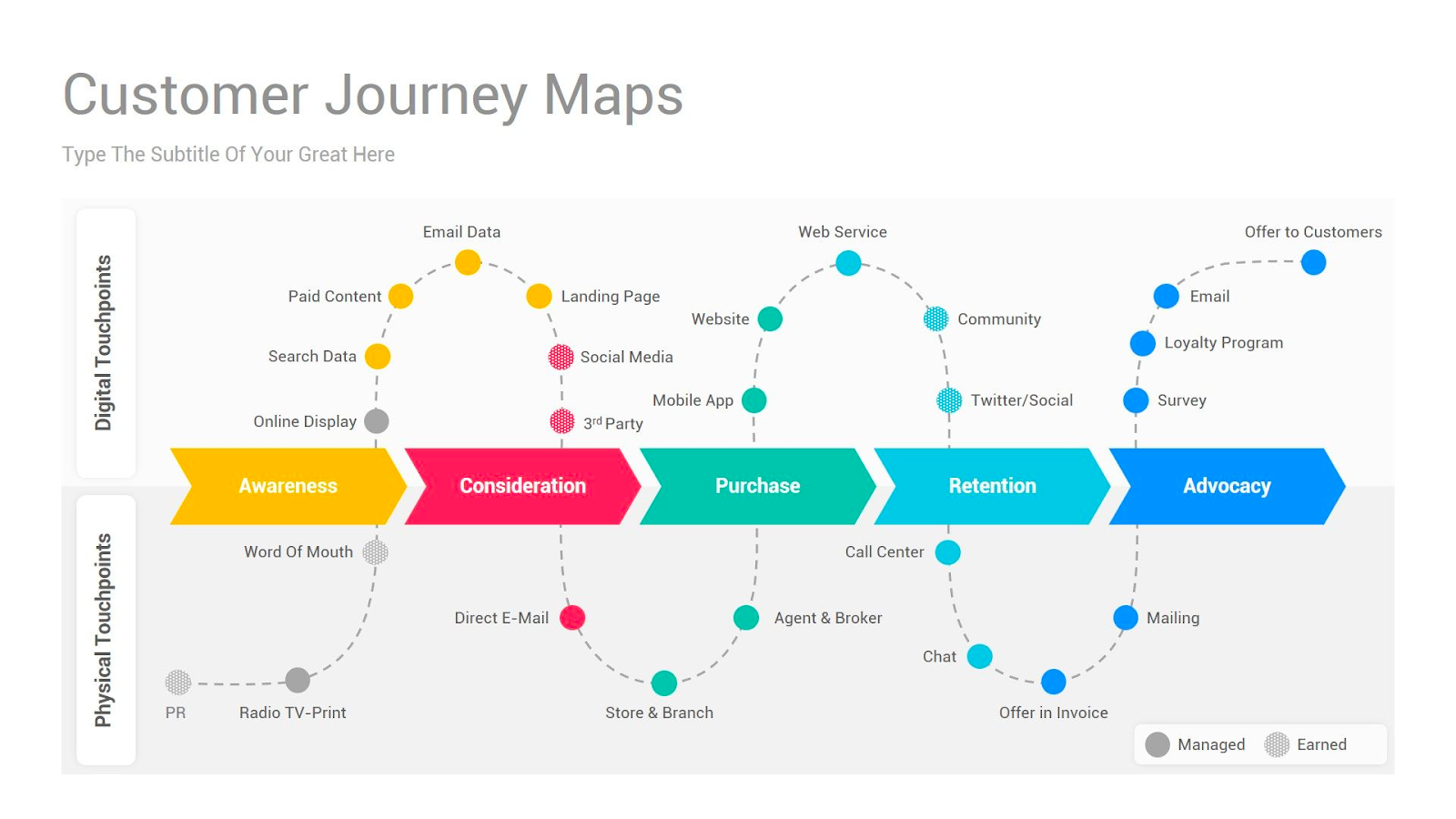 Source: Debutify
Source: Debutify
Notice how it concisely outlines the touchpoints customers take as they move throughout the customer journey.
It starts in the awareness stage with touchpoints like search results or paid content, moves on to the consideration stage with social media or email, then to the purchase stage, and so on.
There are four main purposes of customer journey mapping.
- Flesh out the step-by-step process someone takes from being a potential customer to a lead to an actual customer and ideally, a loyal advocate
- Understand the customer’s perspective
- Identify friction points that are causing issues with customer engagement
- Discover opportunities to reduce pain points and improve the overall customer experience
By doing so, you set the stage for better product design, more effective customer journey marketing, increased customer satisfaction, better customer retention, and ultimately, greater customer success.
How to Create a Customer Journey Map
1. Define Business Goals
Before doing anything else, you’ll want to pinpoint exactly what you’re looking to accomplish with customer journey mapping.
Some common examples include:
- Optimizing each touchpoint in the customer experience
- Identifying areas with higher than average dropoff
- Resolving issues that are leading to excessive dropoff
- Improving the overall customer experience both during the buyer journey and post-purchase
Clearly articulating what you’re trying to achieve is essential because it will direct the path you take for subsequent steps of customer journey mapping.
Note that a big part of effectively defining business goals is getting input from multiple key stakeholders in your company who are responsible for different aspects of the customer experience.
For instance, you may want to get input from your marketing leaders when developing the awareness and consideration stages of your customer journey map, input from your sales leaders when ironing out the purchase stage, and input from your customer service leaders when constructing the retention and advocacy stages.
It’s also smart to perform extensive user research and incorporate customer feedback to ensure you address the right pain points and tackle the issues that are most pressing for creating a positive user experience and long-term customer loyalty.
This should make for cohesive CX journey mapping where touch points flow smoothly from one to the next.
2. Identify Key Stages in the Customer Journey
Next, you’ll want to pinpoint the exact sales funnel stages involved with the customer journey.
The sales funnel stages can vary slightly from company to company, but as we mentioned earlier, some common ones include:
- Awareness
- Consideration
- Purchase
- Retention
- Advocacy
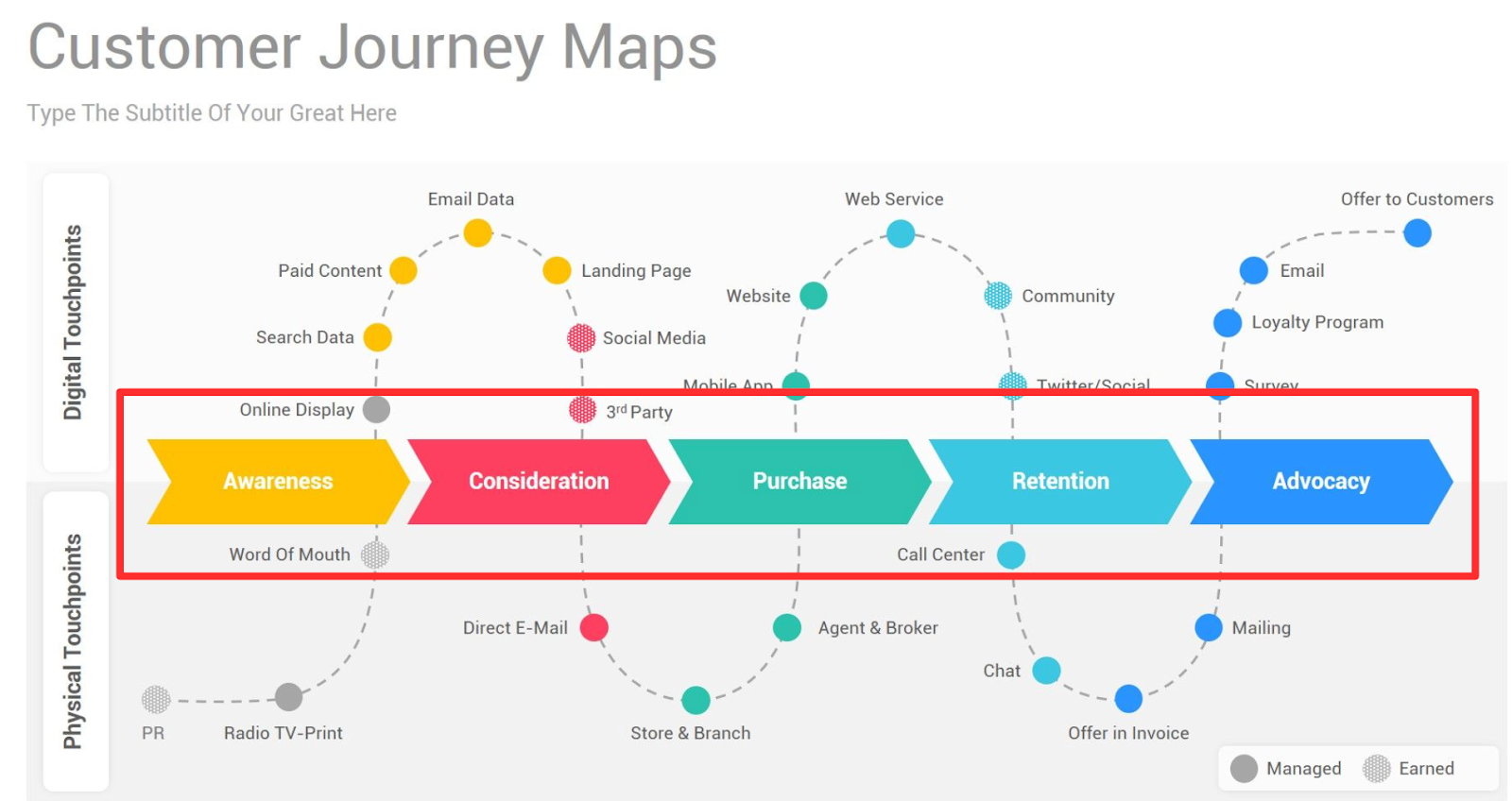 Source: Debutify
Source: Debutify
Fleshing the key stages out like this will show you the path users take as they go from being a prospect to a lead to a customer to an advocate.
By visualizing the key stages like this, you’ll see how each stage flows into the next — something that’s vital for making the customer journey as seamless as possible, meeting customer needs, and improving overall customer experience quality.
This is also what the next step in constructing customer journey maps is built on, which brings us to our next point.
3. Define Customer Touchpoints
You can think of the key stages in the customer journey on the macro level and the next step in the process — defining customer touchpoints — on the micro level.
These are the smaller interactions that customers take as they move from stage to stage in the user journey.
This can include digital touchpoints like becoming aware of your brand through an online ad, a search engine, paid content, and so on.
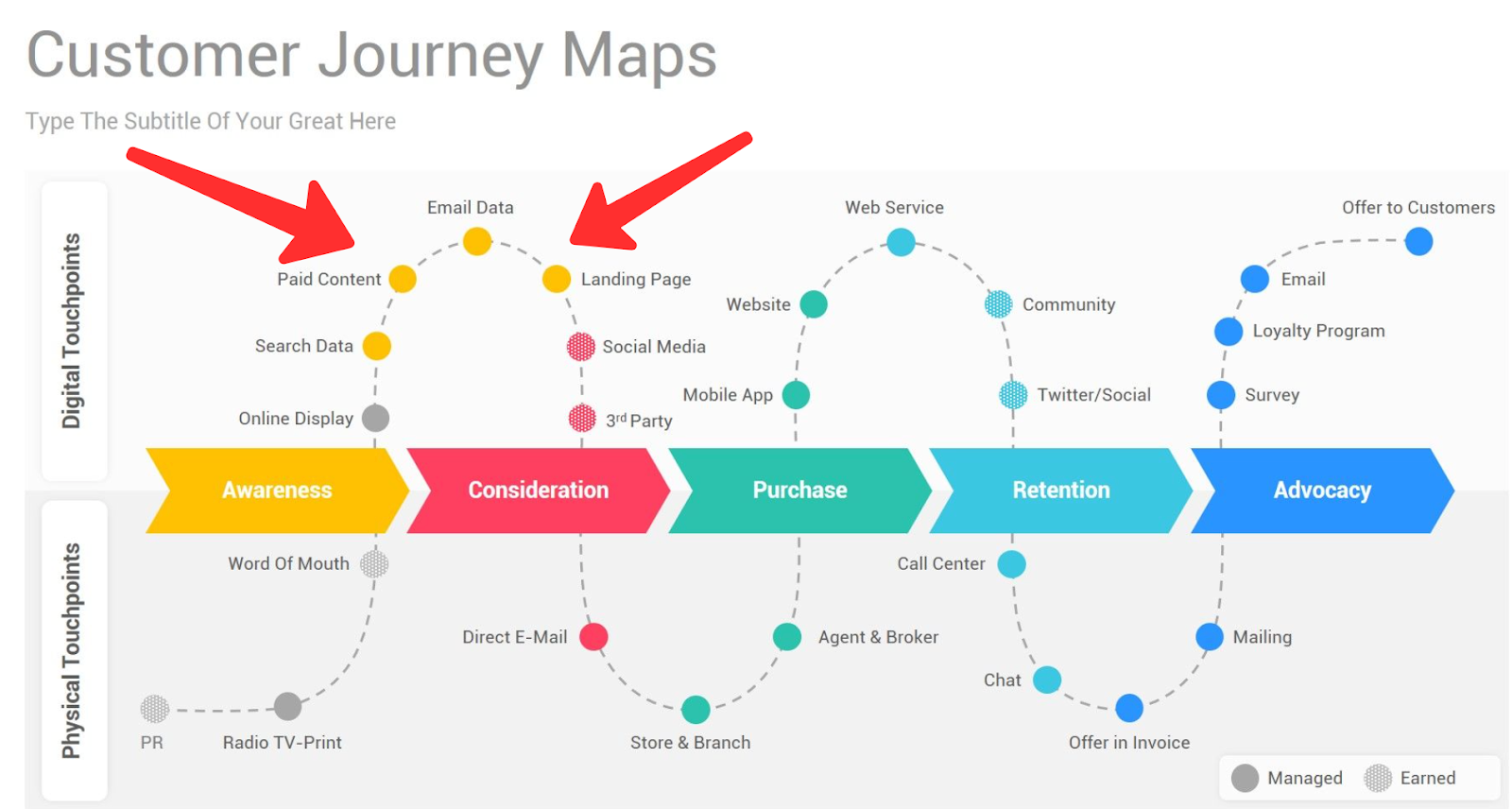 Source: Debutify
Source: Debutify
It can also include physical touchpoints like word-of-mouth.
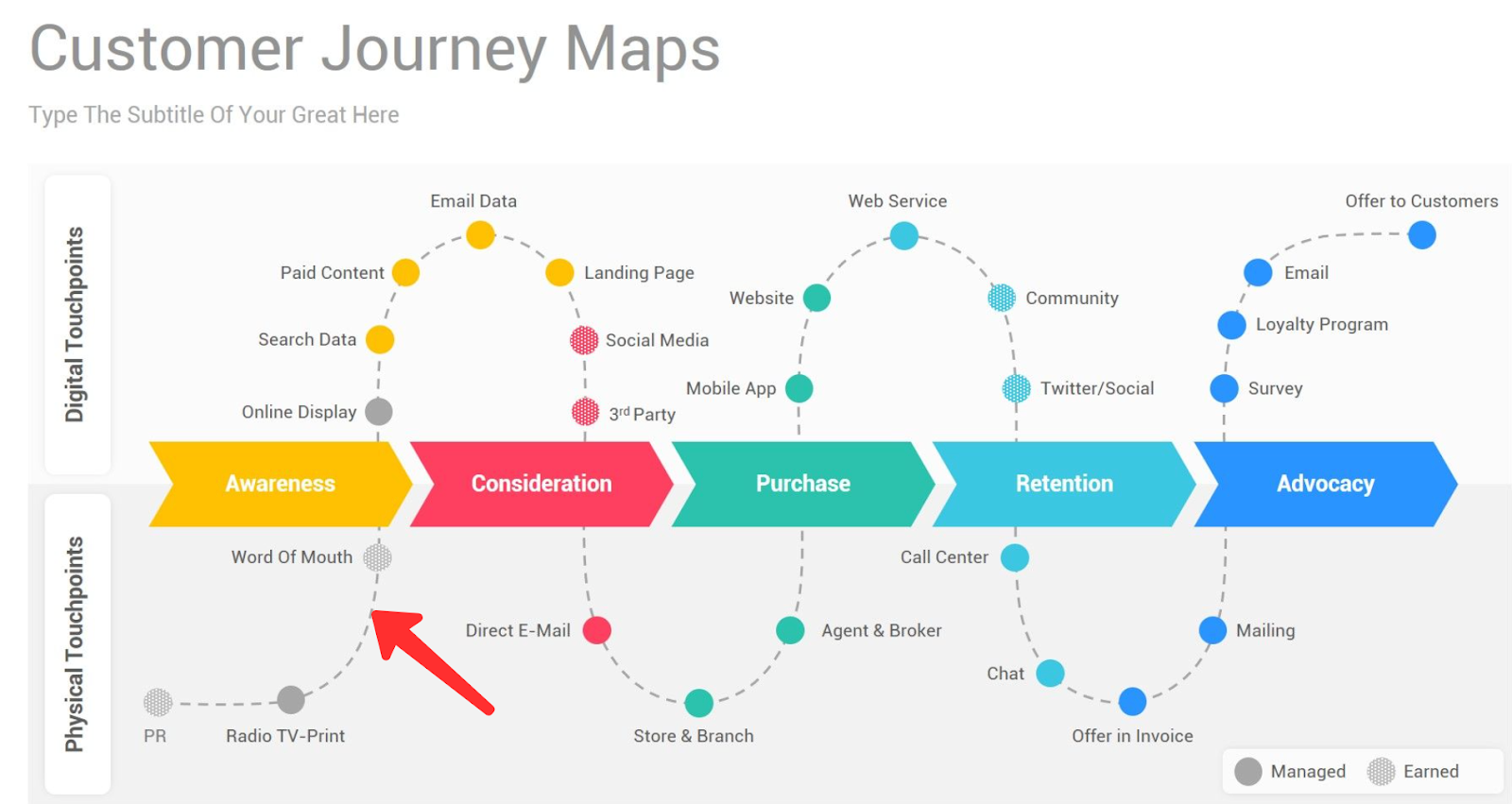 Source: Debutify
Source: Debutify
Customer touchpoints will account for the majority of your customer journey map and help you visualize how people interact with your brand.
The exact number of touchpoints can vary considerably, so defining them is highly individualistic.
When identifying them, you’ll want to carefully consider the typical customer journey and write down every step involved. Then, arrange each touchpoint sequentially so you can see the big picture.
4. Design a Visual Representation of the Customer Journey
After defining business goals, identifying key stages in the customer journey, and defining customer touchpoints, it’s time to actually create your customer journey map.
Here, you’ll create a visual representation of what your business’s specific customer journey looks like for a bird’s-eye view.
To do this effectively, it’s helpful to use strong visual elements like different colors, symbols, bullets, and emojis so you can easily see everything at a glance.
Here’s an example of what an online shopping customer journey map could look like.
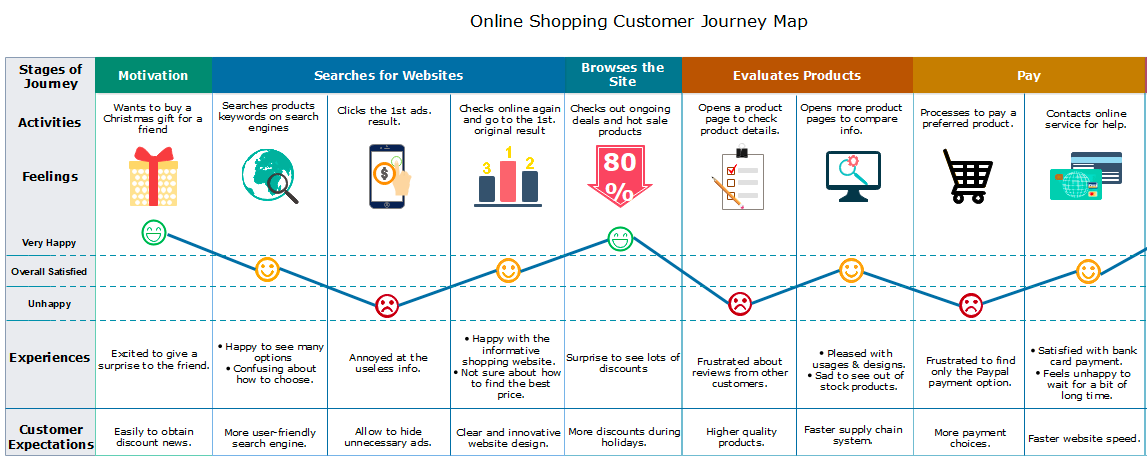 Source: Edraw
Source: Edraw
When it comes to customer journey mapping tools, there are several options available.
If you’re looking for something bare-bones and simple, you can use Microsoft Excel or Google Sheets.
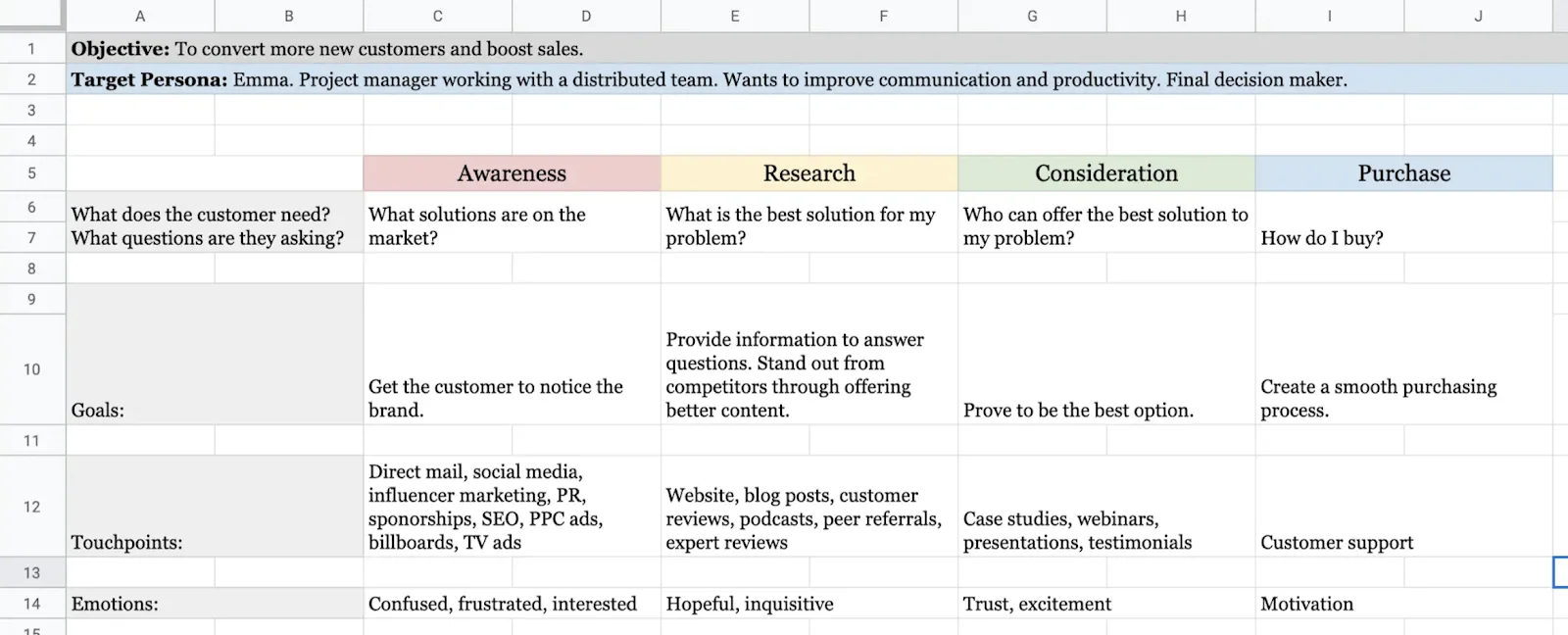
If you want something a bit more advanced, you can use HubSpot’s Customer Journey Map Template, which includes seven free templates (more on this later).
 Source: HubSpot
Source: HubSpot
Or, if you want software with extensive features that are specifically designed for creating customer journey maps, you can find a list of the top 10 products here.
Note that most companies have more than one customer persona. Therefore, you may need to create multiple customer journey maps while targeting each individual buyer persona.
Optimize for Conversion & ROAS Now! Explore Woopra in a demo and enjoy a 2-week free trial: https://www.woopra.com/demo
Customer Journey Map Templates
When most people think of customer journey mapping, they think of the classic buyer’s journey.
And they wouldn’t be wrong.
Generally, that’s the most commonly used customer journey map and the type of mapping we used in the customer journey map examples above.
But it’s certainly not the only type of mapping you can use.
As we’ll learn in a moment, there are also customer journey maps that target specific segments of the buyer’s journey and customer journey maps that focus on what you want your ideal journey to be like.
For the rest of this post, we’ll cover four of the most popular customer journey map templates you can use for different situations.
That way you can cover all the angles and increase the chances of customer success every step of the way.
Buyer’s Journey
As we just mentioned, this is widely considered the most classic type of customer journey mapping.
When mapping the buyer’s journey, you follow the key stages in the customer journey (awareness, consideration, purchase, etc.) like we outlined above, along with customer touchpoints.
Here’s a simple template journey map example for the buyer’s journey from HubSpot, which you can find for free here.
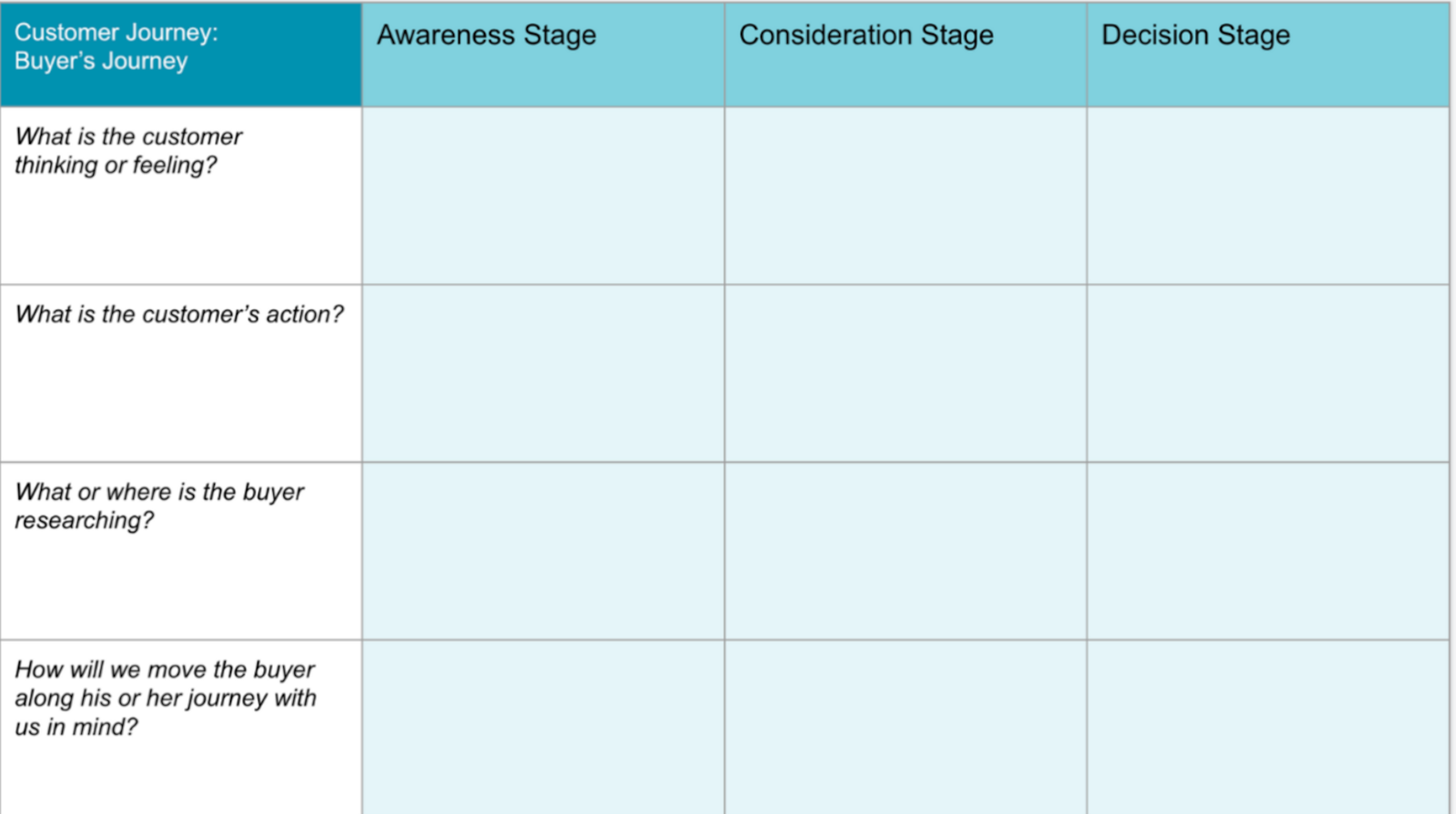 Source: HubSpot
Source: HubSpot
The default starting point is extremely simple. It includes just three stages and a handful of questions to understand customer interaction.
However, you can easily add more stages, questions, and additional information to fully customize the buyer’s journey so that it’s specific to your business.
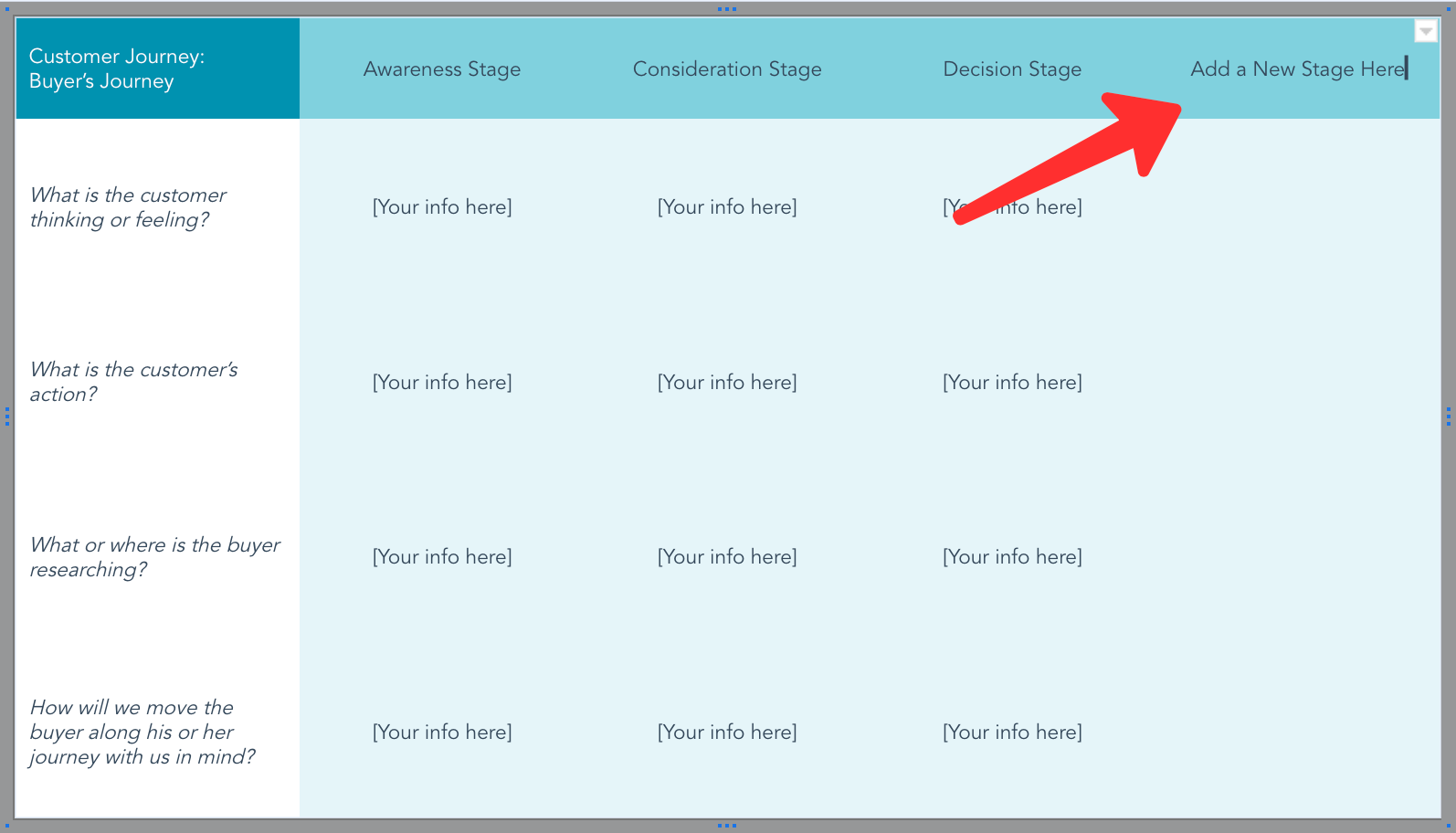 Source: HubSpot
Source: HubSpot
This template, admittedly, won’t provide the same depth as some of the more advanced tools for creating customer journey maps, but it should be adequate for many business owners.
If you don’t need anything fancy and are testing out customer journey maps for the first time, HubSpot should be more than sufficient.
Whatever template you use, buyer’s journey mapping tends to be a good starting point as it helps you visualize the entire process from someone entering your sales funnel to converting to becoming a loyal customer.
This is integral for optimizing every aspect of the customer experience end-to-end, and from a product standpoint, is essential for achieving UX mastery.
It’s also worth mentioning that if you’re looking to improve your UX design skills, The Interaction Design Foundation is an excellent resource for doing so. They offer a wide variety of courses from the beginner to expert level and only charge a flat monthly fee for access to all courses.
Now that we’ve tackled buyer journey mapping, let’s look at three other popular types of customer journey map template options that are also available.
Future State
In most cases, the buyer’s journey is the current journey customers are taking.
While there will likely be several areas you’re satisfied with, your existing customer journey probably won’t be ideal and likely isn’t meeting customer expectations 100%.
For example, there may be friction points along the way where customers are attempting to accomplish a goal. Or, there may be higher than acceptable dropoff in a particular area like using core features or becoming a paid customer after using a free product version.
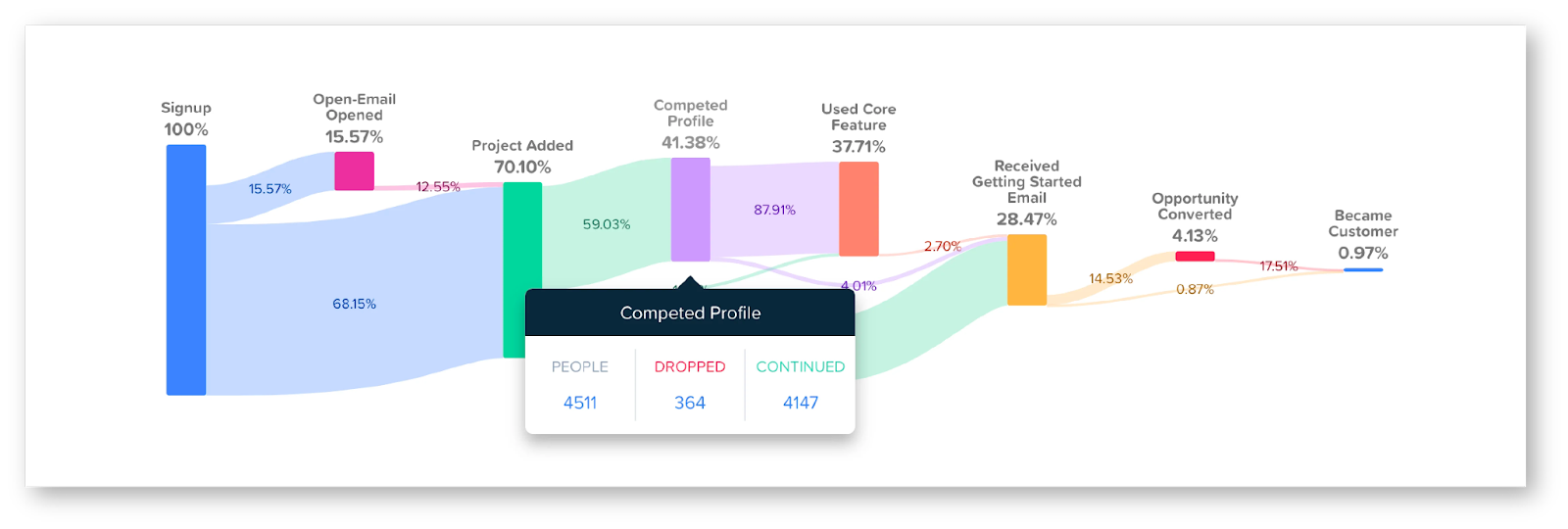
By the way, if you want to holistically understand the customer journey and generate objective customer data, you can use a customer journey analytics platform like Woopra. This enables you to analyze essential customer journey metrics so you can see what it looks like end-to-end.
With future state customer journey mapping, you design a new map with new touchpoints and engagements based on your ideal vision.
That way, you’ll know what needs to be done to create the optimal customer journey.
If you’ve already experimented with creating customer journey maps and are looking to take the next step to refine the customer experience, you’ll likely be interested in future state mapping.
HubSpot offers a free future state template as well, which allows you to outline the series of steps that need to be taken to make the customer journey as perfect as possible. And it’s completely customizable.
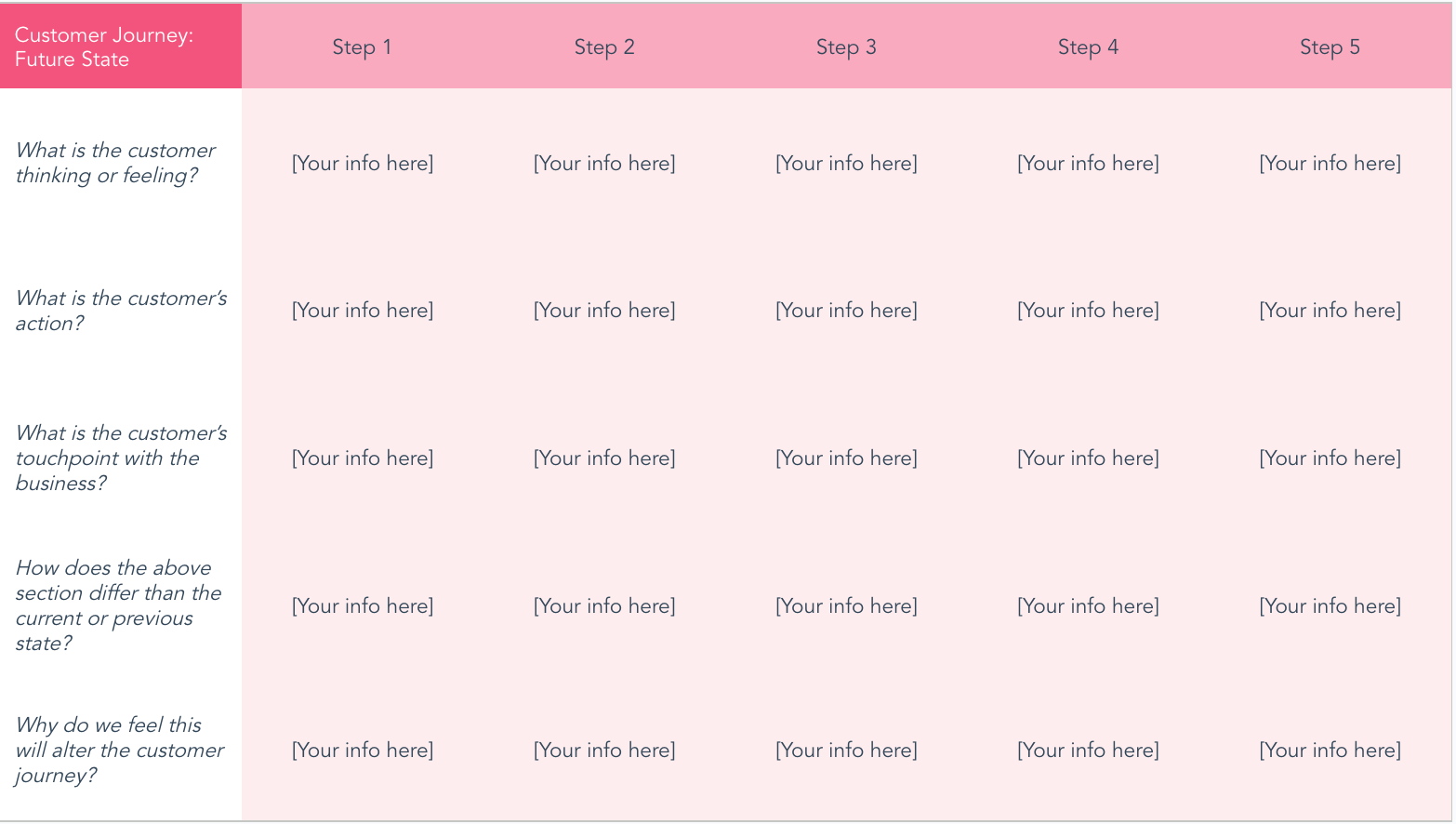 Source: HubSpot
Source: HubSpot
You simply list the steps you want to take to create an amazing customer experience and ask key questions regarding customer behavior.
It’s nothing over the top, but it should get the job done for many business owners.
Lead Nurturing
Although technically part of the buyer’s journey, some marketers choose to create a lead nurturing customer journey map because of the extreme importance of lead nurturing.
After all, any major holes in the lead nurturing process can disrupt sales as a whole. And no matter how good your marketing team is at generating leads, the impact will be negated if you can’t successfully nurture them.
To optimize this area of sales, you can create a lead nurturing map using a template like this one.
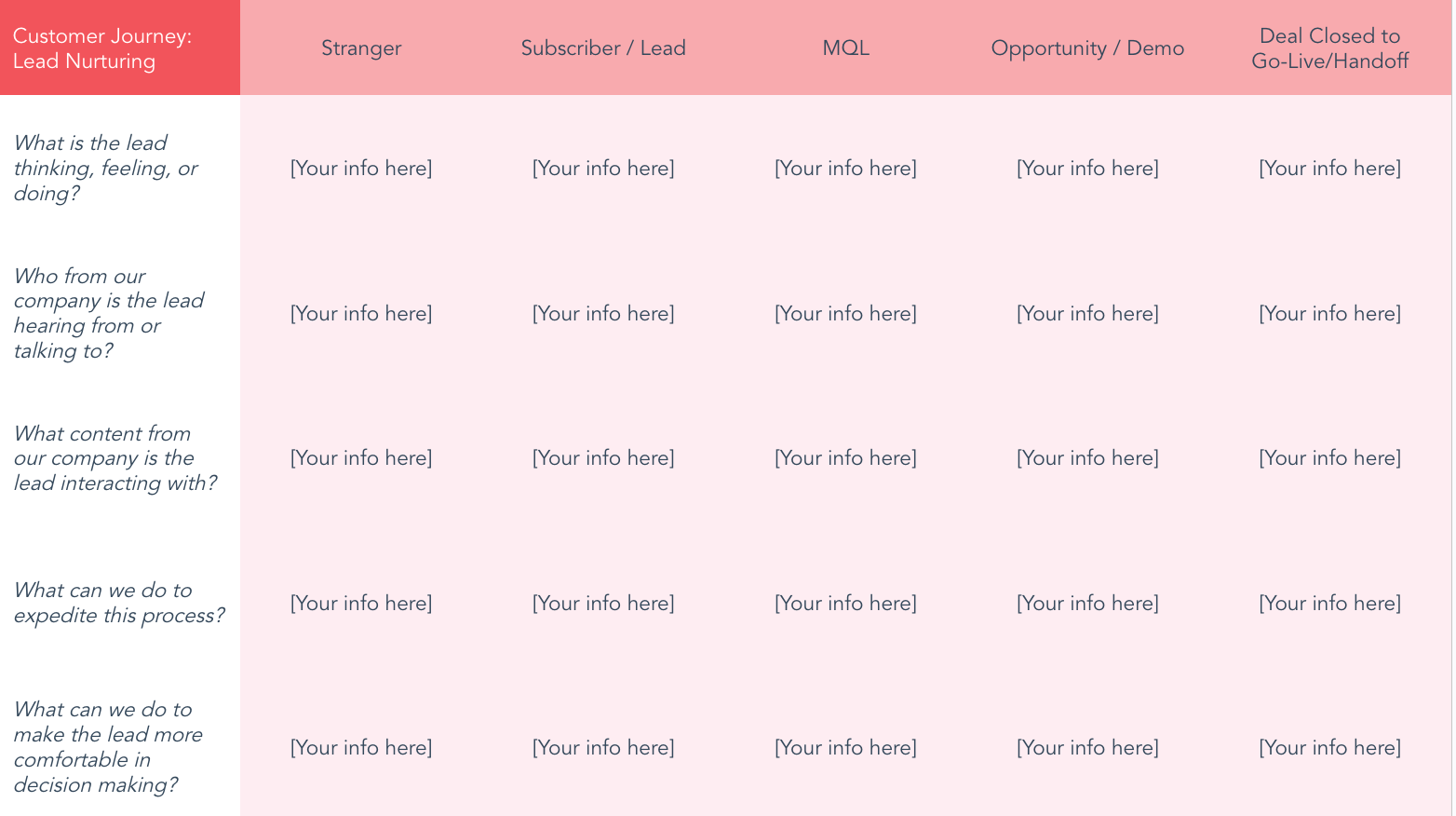 Source: HubSpot
Source: HubSpot
Here, the default starts with someone being a stranger, then moves on to them being a subscriber/lead, then a marketing qualified lead (MQL), a sales opportunity/demo, then a deal closed/handoff.
Again, everything is customizable, so you can adjust the lead nurturing customer journey to your exact specifications. And, it too, is available for free from HubSpot.
Customer Service and Support
Once again, a truly rewarding user experience goes beyond the purchase and ensures a customer is satisfied well after they’ve bought a product.
Like lead nurturing, customer service and support are also technically part of the buyer’s customer journey map.
However, it dives deeper into this area of the sales funnel with the intention of increasing customer retention and advocacy.
And I think we can all agree that this is incredibly important given that “Happy and satisfied customers are 87% more likely to purchase upgrades and new services.”
Here’s yet another free customer journey map template you can get from HubSpot that focuses specifically on customer service and support.
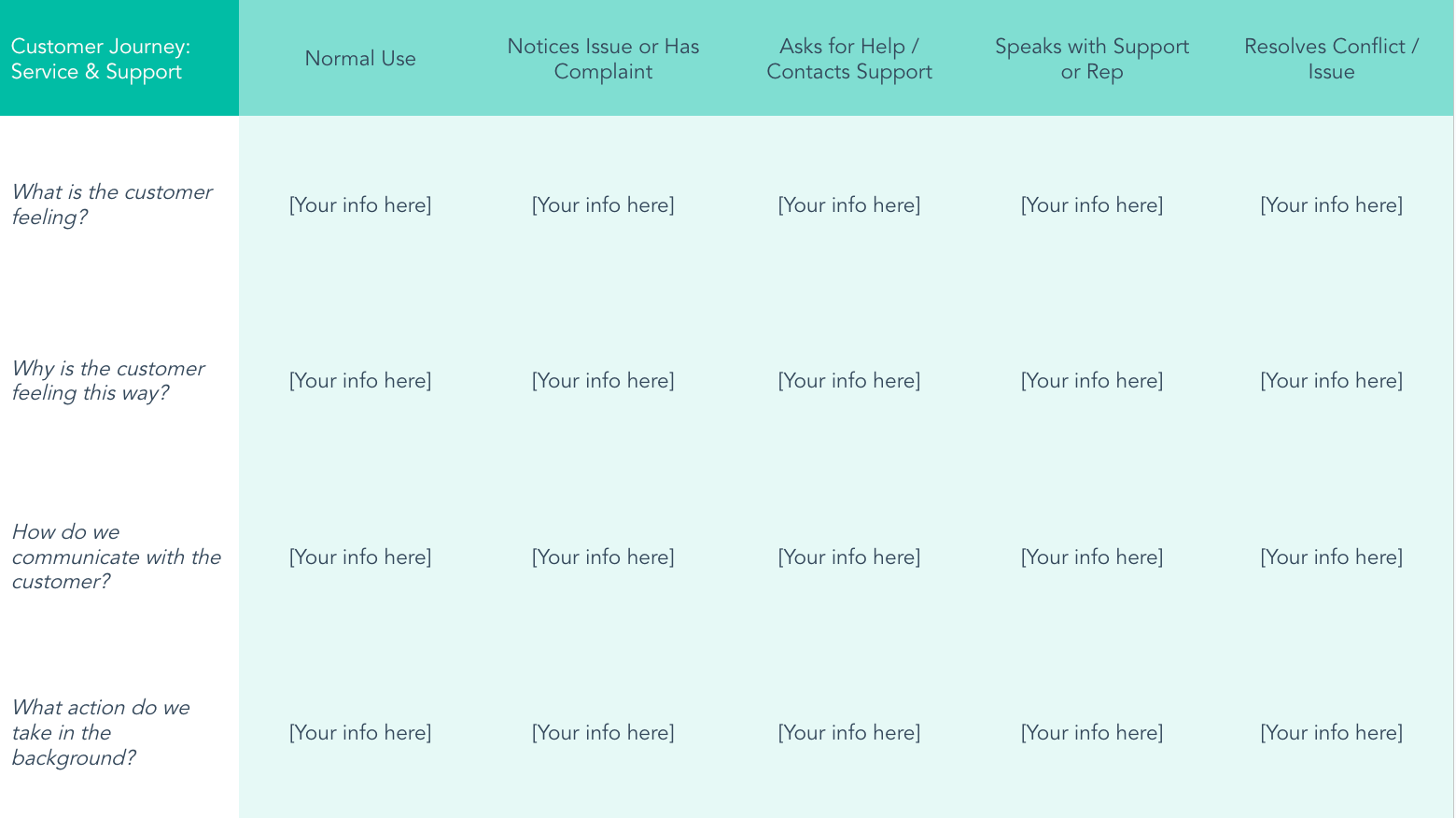 Source: HubSpot
Source: HubSpot
With it, you can follow how a customer goes from engaging in the normal use of a product to noticing an issue/having a complaint to asking for help/contacting customer support to speaking with support to conflict resolution.
Having a clear overview of the touchpoints involved with this process should help you fully understand the flow so you can 1) see things from a customer’s point of view and 2) identify issues that may be detrimental to customer support.
For inspiration from real-life major brands like Spotify, TurboTax, and Amazon, here’s a list of customer journey map examples you can learn from.
Crafting an Exceptional User Experience with Customer Journey Maps
Customer journey mapping is a simple yet effective way to visualize each touchpoint in the user journey holistically for each buyer persona.
From the initial moment someone becomes aware of your brand to the time of purchase and beyond, customer journey maps allow you to see how users move throughout the entire lifecycle.
And as we’ve learned, this serves several important purposes, including seeing the buying process from a customer’s point of view, identifying customer pain points, and unearthing opportunities to improve the customer experience end-to-end.
It’s just a matter of following the correct customer journey mapping guidelines and using the appropriate template to outline the buying process.
Then, tracking key customer journey metrics like engagement, churn rate, and customer satisfaction with an analytics platform like Woopra or Google Analytics should help you refine your customer journey mapping to fully optimize the customer experience.



